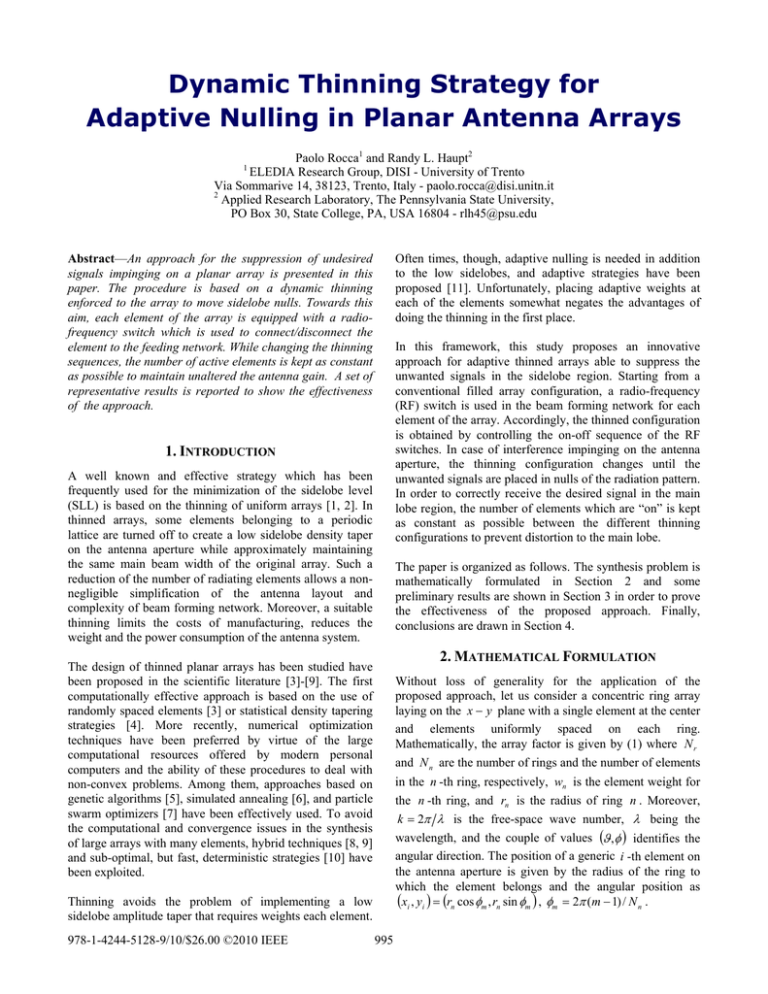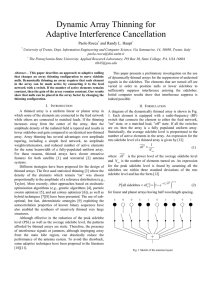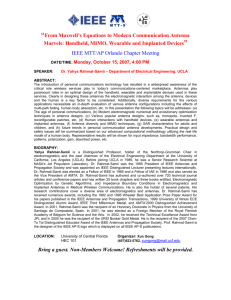Dynamic Thinning Strategy for Adaptive Nulling in Planar Antenna Arrays
advertisement

Dynamic Thinning Strategy for
Adaptive Nulling in Planar Antenna Arrays
Paolo Rocca1 and Randy L. Haupt2
ELEDIA Research Group, DISI - University of Trento
Via Sommarive 14, 38123, Trento, Italy - paolo.rocca@disi.unitn.it
2
Applied Research Laboratory, The Pennsylvania State University,
PO Box 30, State College, PA, USA 16804 - rlh45@psu.edu
1
Often times, though, adaptive nulling is needed in addition
to the low sidelobes, and adaptive strategies have been
proposed [11]. Unfortunately, placing adaptive weights at
each of the elements somewhat negates the advantages of
doing the thinning in the first place.
Abstract—An approach for the suppression of undesired
signals impinging on a planar array is presented in this
paper. The procedure is based on a dynamic thinning
enforced to the array to move sidelobe nulls. Towards this
aim, each element of the array is equipped with a radiofrequency switch which is used to connect/disconnect the
element to the feeding network. While changing the thinning
sequences, the number of active elements is kept as constant
as possible to maintain unaltered the antenna gain. A set of
representative results is reported to show the effectiveness
of the approach.
In this framework, this study proposes an innovative
approach for adaptive thinned arrays able to suppress the
unwanted signals in the sidelobe region. Starting from a
conventional filled array configuration, a radio-frequency
(RF) switch is used in the beam forming network for each
element of the array. Accordingly, the thinned configuration
is obtained by controlling the on-off sequence of the RF
switches. In case of interference impinging on the antenna
aperture, the thinning configuration changes until the
unwanted signals are placed in nulls of the radiation pattern.
In order to correctly receive the desired signal in the main
lobe region, the number of elements which are “on” is kept
as constant as possible between the different thinning
configurations to prevent distortion to the main lobe.
1. INTRODUCTION
A well known and effective strategy which has been
frequently used for the minimization of the sidelobe level
(SLL) is based on the thinning of uniform arrays [1, 2]. In
thinned arrays, some elements belonging to a periodic
lattice are turned off to create a low sidelobe density taper
on the antenna aperture while approximately maintaining
the same main beam width of the original array. Such a
reduction of the number of radiating elements allows a nonnegligible simplification of the antenna layout and
complexity of beam forming network. Moreover, a suitable
thinning limits the costs of manufacturing, reduces the
weight and the power consumption of the antenna system.
The paper is organized as follows. The synthesis problem is
mathematically formulated in Section 2 and some
preliminary results are shown in Section 3 in order to prove
the effectiveness of the proposed approach. Finally,
conclusions are drawn in Section 4.
2. MATHEMATICAL FORMULATION
The design of thinned planar arrays has been studied have
been proposed in the scientific literature [3]-[9]. The first
computationally effective approach is based on the use of
randomly spaced elements [3] or statistical density tapering
strategies [4]. More recently, numerical optimization
techniques have been preferred by virtue of the large
computational resources offered by modern personal
computers and the ability of these procedures to deal with
non-convex problems. Among them, approaches based on
genetic algorithms [5], simulated annealing [6], and particle
swarm optimizers [7] have been effectively used. To avoid
the computational and convergence issues in the synthesis
of large arrays with many elements, hybrid techniques [8, 9]
and sub-optimal, but fast, deterministic strategies [10] have
been exploited.
Without loss of generality for the application of the
proposed approach, let us consider a concentric ring array
laying on the x − y plane with a single element at the center
and elements uniformly spaced on each ring.
Mathematically, the array factor is given by (1) where N r
and N n are the number of rings and the number of elements
in the n -th ring, respectively, wn is the element weight for
the n -th ring, and rn is the radius of ring n . Moreover,
k = 2π λ is the free-space wave number, λ being the
wavelength, and the couple of values (ϑ ,φ ) identifies the
angular direction. The position of a generic i -th element on
the antenna aperture is given by the radius of the ring to
which the element belongs and the angular position as
(xi , yi ) = (rn cos φm , rn sin φm ) , φm = 2π (m − 1) / N n .
Thinning avoids the problem of implementing a low
sidelobe amplitude taper that requires weights each element.
978-1-4244-5128-9/10/$26.00 ©2010 IEEE
995
AF (ϑ ,φ ,U ) = 1 +
Nn
Nr
∑ ∑U
wn
n =1
nm
(t ) exp[ jkrn (cos φm sin ϑ cos φ + sin φm sin ϑ sin φ )]
(1)
m =1
(a)
(b)
Figure 1 – Statistically designed [4] thinned array configuration.
(a)
[
(b)
Figure 2 – Directivity patterns for φ = 0 and ϑ ∈ 0 ,90
o
o
U = {U nm (t ); n = 1,..., N r , m = 1,..., N n }
and
Finally,
U nm (t ) is a rectangular pulse function which can assume
either the value 0 or 1 and mathematically models the
behavior of the RF switch.
( )
l
null
] obtained from the thinning configuration of Fig. 1.
(ϑ ,φ )
null
L
=
U (ϑ ,φ )
l =1
l
null
covers the whole sidelobe region.
The L thinning sequences are then stored in a look up
table. When the antenna is deployed in its operating
environment and the performance (i.e., the signal to noise
plus interference ration, SINR) of the system degrades, the
sequence controlling the RF switches is dynamically
changed among the L configurations until a sufficient
value of SINR is obtained.
In order to minimize the interference level with an efficient
adaptive strategy, a set of L thinning configurations are
computed offline to allow the suppression of the unwanted
signals from whatever direction of the secondary lobe
region of more then a predefined threshold, SSLmin , below
the peak value of the main beam. For each thinned array,
U l , l = 1,..., L , the directions where the following condition
holds true
AF (ϑ ,φ ,U l ) ≤ SLLmin , (ϑ ,φ ) ∈ SLR (ϑ ,φ )
(2)
SLR (ϑ ,φ ) being the region outside the main beam, are
considered as null directions, ϑ ,φ
o
3. NUMERICAL RESULTS
As a preliminary result, let us consider a concentric ring
array made of N r = 8 rings. Half wavelength spacing is
considered both between the rings and approximately
between the elements in a ring. Figure 1 shows two
different statistically thinned arrays obtained through the
, generated by the l -
th pattern. Different thinning configurations are chosen until
996
procedure described in [4] when considering as reference a
Taylor distribution with SLL = −30 dB and n = 5 . It is
simple to observe that if SLLmin = −35dB the corresponding
[5] R. L. Haupt, “Thinned arrays using genetic algorithms,”
IEEE Trans. Antennas Propag., vol. 42, no. 7, pp. 993-999,
Jul. 1994.
patterns, whose φ -cuts for φ = 0 o and ϑ ∈ 0 o ,90 o are
reported in Fig. 2, allows to cover different part of the
sidelobe region as highlighted by the darker strips in Fig.
l
2(a) and Fig. 2(b) representing the null regions, ϑ ,φ null ,
[6] M. Vicente-Lozano, F. Ares, and E. Moreno, “Pencilbeam pattern synthesis with a uniformly excited multi-ring
planar antenna,” IEEE Antennas Propag. Mag., vol. 42, no. 6,
pp. 70-74, Dec. 2000.
l = 1,2 .
[7] J. Nanbo and Y. Rahmat-Samii, “Advances in particle
swarm optimization for antenna designs: Real-number,
binary, single-objective and multiobjective implementations,”
IEEE Trans. Antennas Propag., vol. 55, no. 3, pp. 556-567,
Mar. 2007.
[
]
( )
4. CONCLUSIONS
An innovative approach for the suppression of undesired
signal based on the dynamic thinning of planar arrays has
been presented. A set of RF switches has been used to
adaptively control the on-off sequence to move the nulls of
the corresponding radiation pattern. Some preliminary
results have shown the effectiveness of the proposed
approach.
[8] M. Donelli, A. Martini, and A. Massa, “A hybrid
approach based on PSO and Hadamard difference sets for the
synthesis of square thinned arrays,” IEEE Trans. Antennas
Propag., vol. 57, no. 8, 2491-2495, Aug. 2009.
[9] S. Caorsi, A. Lommi, A. Massa, and M. Pastorino, “Peak
sidelobe reduction with a hybrid approach based on GAs and
difference sets,” IEEE Trans. Antennas Propag., vol. 52, no.
4, pp. 1116-1121, Apr. 2004.
REFERENCES
[1] R. J. Mailloux, Phased Array Antenna Handbook (2nd
ed). Norwood, MA: Artech House, 2005.
[10] D. G. Leeper, “Isophoric arrays - massively thinned
phased arrays with well-controlled sidelobes,” IEEE Trans.
Antennas Propag., vol. 47, no. 12, pp. 1825-1835, Dec 1999.
[2] T. A. Milligan, Modern Antenna Design. New York:
McGraw-Hill, 1985.
[3] Y. T. Lo, “A mathematical theory of antenna arrays with
randomly spaced elements,” IEEE Trans. Antennas Propag.,
vol. 12, no. 3, pp. 257-268, May 1964.
[11] J. T. Mayhan, “Thinned array configurations for use with
satellite-based adaptive antennas,” IEEE Trans. Antennas
Propag., vol. 28, no. 6, pp. 846-856, Nov. 1980.
[4] M. I. Skolnik, J. W. Sherman, and F. C. Ogg, “Statistically
designed density-tapered arrays,” IEEE Trans. Antennas
Propag., vol. 12, no. 4, pp.408-417, Jul. 1964.
997





